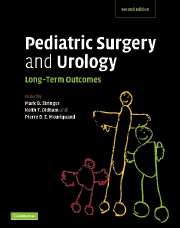Book contents
- Frontmatter
- Contents
- List of contributors
- Acknowledgments
- Preface
- Part I General issues
- 1 Introduction and historical overview
- 2 Principles of outcomes analysis
- 3 Outcomes analysis and systems of children's surgical care
- 4 Perinatal mortality and morbidity: outcome of neonatal intensive care
- 5 Psychological aspects of pediatric surgery
- Part II Head and neck
- Part III Thorax
- Part IV Abdomen
- Part V Urology
- Part VI Oncology
- Part VII Transplantation
- Part VIII Trauma
- Part IX Miscellaneous
- Index
- Plate section
- References
3 - Outcomes analysis and systems of children's surgical care
from Part I - General issues
Published online by Cambridge University Press: 08 January 2010
- Frontmatter
- Contents
- List of contributors
- Acknowledgments
- Preface
- Part I General issues
- 1 Introduction and historical overview
- 2 Principles of outcomes analysis
- 3 Outcomes analysis and systems of children's surgical care
- 4 Perinatal mortality and morbidity: outcome of neonatal intensive care
- 5 Psychological aspects of pediatric surgery
- Part II Head and neck
- Part III Thorax
- Part IV Abdomen
- Part V Urology
- Part VI Oncology
- Part VII Transplantation
- Part VIII Trauma
- Part IX Miscellaneous
- Index
- Plate section
- References
Summary
Institutions which provide the basis for contemporary children's specialty units and pediatric clinical care first developed in the nineteenth and early twentieth centuries. These reflected efforts to care for urban populations of children brought together by the forces of industrialization and were often the work of altruistic individuals, typically but not exclusively, well-to-do women, who were motivated by compassion for children. Their primary mission was often to provide an acceptable level of charity care to poor children in their communities. This is, in fact, still the case for many major children's hospitals worldwide.
The concept that children are unique patients with particular developmental, physiological and psychological needs, for whom a demonstrably better outcome could be obtained with specialized medical care came more recently. With particular regard to children's surgical care, events detailed in Chapter 1 by Dr. Hendren (North America) and Dr. O'Donnell (Europe/UK) gave rise to what we recognize as contemporary pediatric surgery by the mid twentieth century. Specialization and credentialing were progressively driven by the view that the quality of care for children was improved by having practitioners fully dedicated to children, by providing focused professional training for individuals interested in childhood disease, and by creating a children's specific environment for the delivery of that care. The wider medical community has not been free of controversy over these points. Perceived economic threat and fear of professional or institutional loss remain powerful forces even today when we discuss issues like regionalization or consolidation of certain services.
- Type
- Chapter
- Information
- Pediatric Surgery and UrologyLong-Term Outcomes, pp. 29 - 38Publisher: Cambridge University PressPrint publication year: 2006

